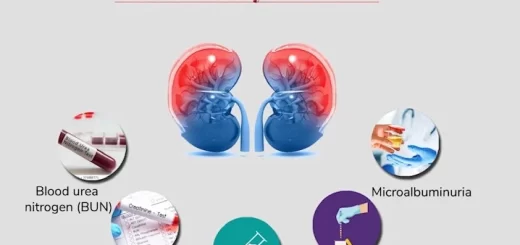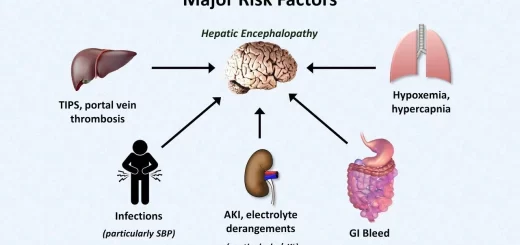Lung structure, borders, Lobes, Fissures and Broncho-pulmonary segments
Lung
The lung like half a cone in shape; has an apex, a bass, three borders (anterior-posterior and inferior), and two surfaces (Medial and costal). The lungs extract oxygen from the atmosphere and transfer it into the bloodstream, and release carbon dioxide from the bloodstream into the atmosphere, in a process of gas exchange. The medial surface is divided into a (Mediastinals vertebral). Apex extends up 1 inch above and behind the medial third of the clavicle. The base is concave in shape. It is related to:
- Diaphragmatic pleura.
- The copula of the diaphragm.
- The liver (right lung) …………… Liver, stomach (fundus), and spleen (left lung).
Borders
- Anterior border is a sharp border and occupies the costo-mediastinal recess of the pleura, The lower part of the anterior border of the left lung contains the cardiac notch (just below the cardiac notch, there is a projection called the lingula).
- Posterior border is a rounded border and occupies the para-vertebral gutter.
- Inferior border protrudes through the costo- diaphragmatic recess.
Surfaces of the lung:
- Costal surface is related to the thoracic wall and costal pleura.
- Medial surface: Vertebral surface related to the paravertebral gutter, and Mediastinal surface: contains the hilum of the lung and is related to mediastinal structures.
Lobes and Fissures of the lungs:
Right lung
The right lung is divided into three lobes (superior, middle, and inferior) by two fissures:
- Oblique fissure begins at the posterior border of the lung opposite the fourth thoracic spine & ends at the inferior border opposite the six costo-chondral junction.
- Transverse fissure begins at the anterior border opposite the fourth costal cartilage.
Left lung
The left lung is divided into two lobes (superior and inferior) by the oblique fissure. Oblique fissure (surface anatomy) begins at the posterior border of the lung opposite the third thoracic spine (it inch lateral to the spine) & ends at the inferior border opposite the six costochondral junctions.
Mediastinal Surface of the Right Lung
- Candiac impression, related to right atrium and pericardium.
- Superior vena cava.
- Inferior vena cava.
- Right innominate vein.
- Arch of the azygos vein.
- Azygos vein.
- Oesophagus.
- Trachea.
- Right vagus nerve.
- The right phrenic nerve.
- Ascending aorta & Thymus.
Mediastinal Surface of the Left Lung
- Cardiac impression, related to left ventricle and pericardium.
- Arch of the aorta.
- Descending aorta.
- Left common carotid artery.
- Left subclavian artery.
- Oesophagus.
- Thoracic duct.
- Left vagus nerve.
- Left phrenic nerve.
- Pulmonary trunk and thymus.
Hilum of the lungs
Hilum of the lungs offers passage to the structures forming the root of the lung.
- Bronchus.
- Pulmonary artery.
- Pulmonary veins.
- Hilar lymph nodes.
- Bronchial vessels.
- Pulmonary plexuses (anterior and posterior).
- Pulmonary ligament.
Hilum of the left lung: contains:
- One bronchus (most posterior structure).
- Pulmonary artery (anterior and above the bronchus).
- Two pulmonary veins (most anterior and inferior structures).
Hilum of right lung contains:
- Two Bronchi (Cparterial and hyparterial) most posterior structures).
- Pulmonary artery (anterior and in between the two bronchi) structures).
- Two pulmonary veins (most anterior and inferior.
Difference between the right and left lungs
Right lung:
- Size and weight: Larger and heavier.
- Length and breadth: Shorter and wider.
- Lobes and fissures: Two fissures, and Three lobes.
- Anterior border: No cardiac notch.
Left Lung:
- Size and weight: Smaller and lighter.
- Length and breadth: Longer and narrower.
- Lobes and fissures: One fissures, and Two lobes.
- Anterior border: Cardiac notch & lingula.
Broncho-pulmonary segments:
Every bronchopulmonary segment is a discrete anatomical and functional unit, Having its own bronchus, and artery, This separation means that the bronchopulmonary segment can be surgically removed without affecting the function of the other segments.
Right Lung:
- Superior lobe: Apical, Anterior, and Posterior.
- Middle lobe: Medial, Lateral.
- Inferior lobe: Apical basal, Medial basal, Lateral basal, Anterior basal, Posterior basal.
Left Lung:
- Superior lobe: Apicoposterior, Anterior, Sup. lingular, and Inf. lingular.
- Middle lobe:
- The inferior lobe: Apical basal, Lateral basal, Anteromedial basal, and posterior basal.
Surface anatomy of the lung (and visceral pleura):
The anterior border is the same as the parietal pleura, The inferior border is demarcated by joining the following bony points:
- A point on the six ribs in the mid-clavicular line.
- the point on the eighth rib in the mid-axillary line.
- A point 1 inch0 lateral to the tenth thoracic spine.
Nerve supply:
- Sympathetic (2-5 thoracic sympathetic ganglia) causes broncho-dilatation.
- Parasympathetic (vagi) causes broncho-constriction + Increases the secretion of the glands.
Blood supply:
Clinical notes:
- The cardiac notch of the left lung: It lies at the medial ends of the 4th and 5th intercostal spaces and related to the apex of the heart. This area is used for a pericardial puncture (to aspirate fluid from the pericardium), as the introduced needle will not pass through the pleura or the lung tissue.
- Stab wounds in the mid-axillary line: Above the 8th rib, lead to injury of the lung and pleura. Between the 10th and 8th rib, lead to injury of the pleura only.
- Injury of the pleura leads to the following: Entry of air into the pleural cavity (pneumothorax). The collapse of the lung tissue (atelectasis).
- Collection of fluids in the pleura: Serous→ hydrothorax. Pus→pyothorax. Blood→ Haemothorax.
- Foreign body entering into the trachea: It reaches the right lung more commonly than the left because the right main bronchus is shorter, wider, and more in line with the trachea.
- If in the recumbent position: It enters the apical segment of the inferior lobe because it is the first posterior branch of the bronchial tree.
- If in the erect position: It enters the posterior basal segment because it is the most dependent branch of the bronchial tree (follows the line of gravity).
Larynx structure, function, cartilage, muscles, blood supply and vocal folds
Anatomy of nose, function of para-nasal air sinuses and Sphenopalatine Ganglion branches
Thoracic vertebrae structure, function, Chest wall muscles and Intercostal arteries
Diaphragm anatomy, structure, function, Phrenic nerves and Nerves of the thorax



